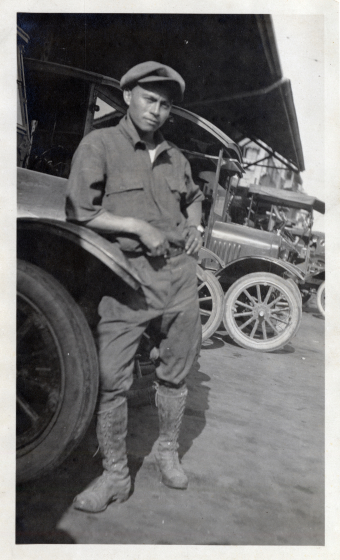First Smithsonian Asian Pacific American Center Exhibition at the National Museum of American History Explores Stockton’s Little Manila
The Smithsonian Asian Pacific American Center (APAC) will open its next exhibition, “How Can You Forget Me: Filipino American Stories,” Nov. 20 at the Nicholas F. and Eugenia Taubman Gallery in the Smithsonian’s National Museum of American History. This marks APAC’s first exhibition at the museum and is its signature program for the Smithsonian’s celebration of the nation’s semiquincentennial, “Our Shared Future: 250.” The exhibition explores the history of Filipino American migration, labor and community-building in Stockton, California—once home to the largest Filipino community outside the Philippines—from the 1910s to the 1970s.
 “How Can You Forget Me” is anchored by more than 50 artifacts recovered from a trove of steamer trunks discovered in 2005 in the basement of the Daguhoy fraternal lodge in Stockton’s Little Manila district. The exhibition features three of these trunks as both literal containers and symbolic vessels, revealing valuable insights into how Filipino migrants lived, worked, loved and built community. One of the three trunks was donated to the museum in 2022 by the Stockton-based nonprofit Little Manila Rising, which works to preserve the city’s Filipino American heritage and legacy.
“How Can You Forget Me” is anchored by more than 50 artifacts recovered from a trove of steamer trunks discovered in 2005 in the basement of the Daguhoy fraternal lodge in Stockton’s Little Manila district. The exhibition features three of these trunks as both literal containers and symbolic vessels, revealing valuable insights into how Filipino migrants lived, worked, loved and built community. One of the three trunks was donated to the museum in 2022 by the Stockton-based nonprofit Little Manila Rising, which works to preserve the city’s Filipino American heritage and legacy.
Each trunk serves as a time capsule, offering a distinct story and inviting visitors to unpack the intimate and collective experiences that shaped the journey of Filipino Americans in Stockton. From three-piece suits and ceremonial regalia to agricultural tools, family photographs, diaries and everyday objects, these belongings—long stored and forgotten—shed light on the lives of manongs, who forged deep bonds within their communities. The term manong—meaning “older brother” in Ilocano, a Filipino language—is used affectionately to describe these early Filipino labor migrants, many of whom were single men.
The exhibition’s title, “How Can You Forget Me,” is drawn from an embroidered pillowcase found in the trunk donated to the Smithsonian. The phrase expresses both personal longing and broader themes of memory and remembrance—sentiments that echo throughout the exhibition. A dedicated interactive section of the gallery offers visitors a chance to reflect on the objects and stories and to explore how early Filipino migrants navigated identity and belonging across the Filipino diaspora.
“These steamer trunks do not just tell the story of one Filipino American community in California,” said Sam Vong, the exhibition’s curator. “They tell an American story of immigrants fighting to preserve their history, of families struggling not to forget and not to be forgotten. That’s why these stories are so powerful: they’re about everyday people and about experiences we have all shared.”
Vong, a curator of Asian Pacific American history at the National Museum of American History, was supported by curatorial assistant Ethan P. Johanson. The exhibition is designed by the award-winning firm TSKP x IKD and will be on view for two years. A companion website featuring educational materials and a virtual gallery will launch alongside the exhibition.
The opening of the exhibition will be accompanied by a screening of the documentary Delano Manongs: Forgotten Heroes of the United Farm Workers, Nov. 20 from 7 to 9 p.m. in the museum’s Warner Bros. Theater. Co-presented by APAC and the museum’s History Film Forum, the event will include a post-screening discussion with director Maríssa Aroy, Dillon Delvo of Little Manila Rising and others. Additional public and educational programs—including panels, workshops and film screenings—will be offered throughout the exhibition’s run.
“How Can You Forget Me” invites in-person and virtual visitors to engage with a deeply place-based history of Filipino America—and by extension, of the United States—leading up to and throughout the nation’s 250th anniversary.
“As we approach the nation’s semiquincentennial, the exhibition deepens our understanding of the American experience by highlighting stories of resilience, resourcefulness and community,” said Yao-Fen You, APAC’s acting director.
“How Can You Forget Me” is supported by grants from the Henry Luce Foundation, the Surdna Foundation and the Coby Foundation. The exhibition has also received federal funding from the Asian Pacific American Initiatives Pool, administered by APAC, and the Latino Initiatives Pool, administered by the National Museum of the American Latino.
About the Smithsonian Asian Pacific American Center (APAC)
APAC, established in 1997, ensures the comprehensive representation and inclusion of Asian Americans, Native Hawaiians and Pacific Islanders across the Smithsonian’s collections, research, exhibitions and programs. Through education initiatives, publications and public programs, APAC provides new avenues to document, celebrate and share the rich and diverse history, art and culture of Asian American, Native Hawaiian and Pacific Islander communities. APAC’s exhibitions, “How Can You Forget Me” and “Sightlines: Chinatown and Beyond” (on view at the Smithsonian American Art Museum through November 30, 2025) will pave the way for a dedicated APAC gallery on the National Mall.
For more information about the center, visit its website and follow it on Instagram and Facebook.
